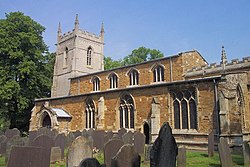Ashby Folville
| Ashby Folville | |
| Leicestershire | |
|---|---|
 St Mary's Church, Ashby Folville | |
| Location | |
| Grid reference: | SK706120 |
| Location: | 52°42’5"N, 0°57’22"W |
| Data | |
| Post town: | Melton Mowbray |
| Postcode: | LE14 |
| Dialling code: | 01664 |
| Local Government | |
| Council: | Melton |
| Parliamentary constituency: |
Rutland and Melton |
| Website: | http://www.ashbyfolville.com |
Ashby Folville is a village in Leicestershire, south-west of Melton Mowbray.
Contents
Parish church
The parish church of St Mary was restored after the Ashby Folville estate was bought in 1890 by Herbert Smith-Carington, then Mayor of Worcester: he built cottages and a village institute and restored the church. The old wooden roofs of the nave and the new oak panels of the chancel and screen of the Woodford chapel are among the features of interest.
In the chancel are memorials to Ralph Woodford (a descendant of the Folvilles) and Elizabeth Woodford. Monuments in the Woodford chapel include a stone knight known as "Old Folville" and the fine monument of Sir Francis Smith and his wife.[1] Stained glass windows by Veronica Whall and Edward Woore were erected in memory of members of the Smith-Carington family.
The church is a Grade I listed building.
History
The village of 'Ashby' is recorded in the Domesday Book as consisting of twenty-four villagers, three smallholders, two serfs, one priest and being owned by the Countess Judith.[2]
By the time of the Leicestershire Survey of 1124-29 the manor had passed from Judith to her daughter Maud, Countess of Huntingdon and her husband King David I of Scotland.
The Folville Family
The 'Folville' element of the village's name comes from a family that had its seat here since at least 1137 when its lordship was held of the Honour of Huntingdon by Fulk de Folville.[3] The family name was attached to several other sites in Leicestershire, including the deserted village of Newbolt Folville.[4] The family were well-established in Leicestershire by the mid-13th century.
The Folvilles were rebels during both Barons' Wars; Sir William Folville (died about 1240) had his lands seized for his part in the First Barons' War in 1216[3] and Sir Eustace Folville (murdered in 1274) was one of the knights appointed to enforce the Provisions of Oxford in 1258[5] and stoutly defended Kenilworth Castle after the Battle of Evesham in 1265.[3]
The family gained renown during the reign of King Edward II, when they ambushed and killed the Baron of the Exchequer, Roger de Beler. Hugh le Despenser, 1st Earl of Winchester had been stealing lands in Leicestershire using Roger de Beler as an enforcer, and in 1325 de Beler had threatened the Folville family with violence.[6] By the beginning of 1326 much of the country had turned against Edward and the Despencers and preparations for a rebellion led by Edward's wife, Queen Isabella and Roger Mortimer had started.[7] The Folville family, headed by Eustace Folville, and encouraged by Sir Roger la Zouch, Lord of Lubbesthorpe murdered de Beler before fleeing to Paris. Following Isabella and Mortimer's successful invasion of England, Edward III was crowned and rebels were pardoned including the Folville family who were celebrated locally with the Folville Cross, said to be located at the site of de Beler's murder.
The Folville clan flitted in and out of outlawry for many years, but, apart from Richard Folville, vicar of Teigh, who was beheaded in his own churchyard, they ended with their freedom intact.
The manor of Ashby eventually passed via marriage from the Folvilles to the Woodfords and then Smiths.[3]
After the War
After the Second World War, a resettlement camp for displaced people from Poland was established in a former US Army base in the grounds of Ashby Folville Manor.[8]
References
- ↑ Firth 1926, p. 272-5.
- ↑ Folville Ashby Folville in the Domesday Book
- ↑ 3.0 3.1 3.2 3.3 Nichols 1795.
- ↑ Primrose 1889, p. 17.
- ↑ VCH Rutland II 1935.
- ↑ Lumley 1895.
- ↑ Fryde 1979.
- ↑ "Polish reunion is resounding success", Melton Times 14 Sept 2010
- Farnham, George (1919-1920). Leicestershire Manors: The Manors of Allexton, Appleby and Ashby Folville. Leicester: Leicestershire Archaeological and Historical Society. https://www.le.ac.uk/lahs/downloads/Vol11Allextonetal.pdf.
- Firth, J.B. (1926). Highways and Byways in Leicestershire. London: Macmillan.
- Fryde, Natalie (1979). The Tyranny and Fall of Edward II 1321-1326. Cambridge: Cambridge University Press. ISBN 9780521222013. https://books.google.com/books?hl=en&lr=&id=MekRPcFKOHAC.
- A History of the County of Leicester - Volume 5 pp 81-84: {{{2}}} (Victoria County History)
- Lumley, Joseph (1895). Chronicon Henry Knighton. I. London: HMSO.
- Nichols, John (1795). The History and Antiquities of the County of Leicester. Leicester: John Nichols.
- Primrose, Catherine L.W (1889). The Battle Abbey Roll: with some account of the Norman lineages. I. London: John Murray.
Outside links
| ("Wikimedia Commons" has material about Ashby Folville) |